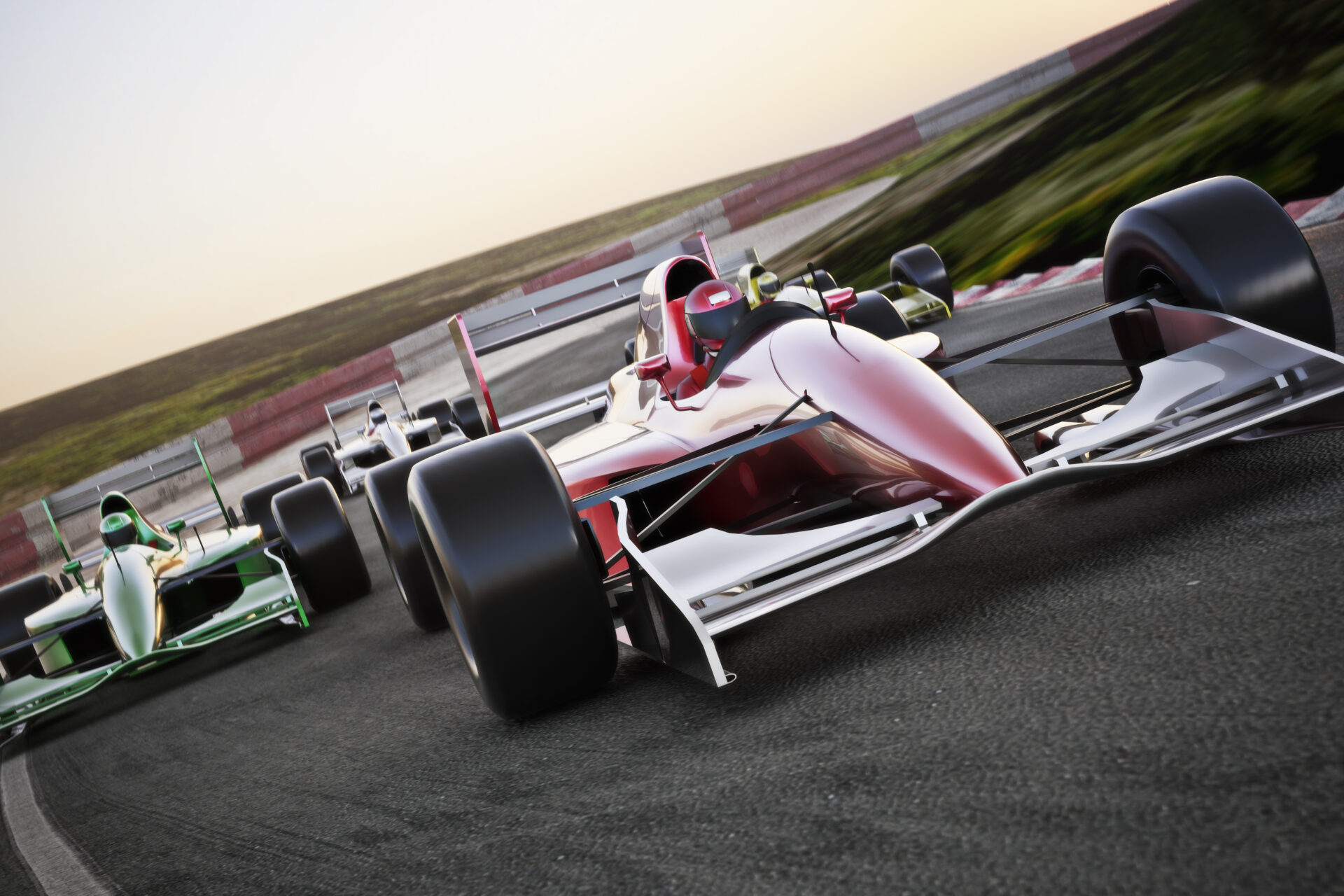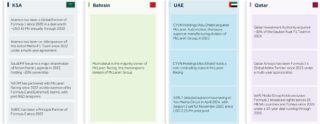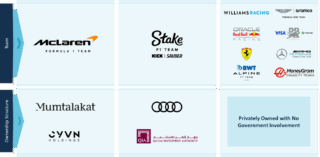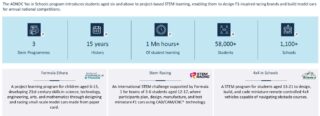
Introduction
Motorsport has deep roots across the GCC, with a vibrant local enthusiasm for car culture and competitive racing that dates back decades. From early rally events in Qatar dating back to the 1960s and 1970s to the popular desert activity of dune bashing in the UAE, GCC countries have fostered a strong racing community for over half a century. Yet for much of this period, the region lacked permanent international-standard circuits or major global events, limiting both its economic impact and its brand recognition on the world stage. Since the beginning of the century, there has been a gradual shift in the landscape as the Middle East has been steadily positioning itself as a vibrant hub for motorsport excellence driven primarily by strategic considerations. This transformation began in 2004 with the opening of three major international-standard circuits, each hosting International Automobile Federation (FIA) or International Motorcycling Federation (FIM)-certified premier events.
These initial investments ushered a broader transformation across the GCC. What began as a bid to attract elite motorsport to the region has grown into a broader strategy that utilizes various motorsport categories to support economic diversification, cultural development, and technological advancement.
The GCC’s Rise in Global Motorsport
Today, motorsport has become a key component of national development plans throughout the GCC. Since 2021, Saudi Arabia has invested more than USD 6 billion into the sports industry in support of Vision 2030’s diversification goals with motorsport emphasized across various investments and events. Similarly, UAE positions sports, and motorsport in particular, as a key pillar of its post-oil economy, leveraging its status as a global trade and investment hub to drive innovation, tourism, and infrastructure growth.
Bahrain, home to one of the region’s longest-running FIA-certified circuits, supports motorsport to boost tourism and diversify its economy whereas Qatar hosts premier events at Lusail International Circuit, including MotoGP and Formula 1, aligning motorsport with its goals of tourism expansion and global visibility. This coordinated approach extends beyond hosting events, with substantial investments fostering a broad motorsport ecosystem across the region. Central to the region’s ambitions are established regional sovereign wealth funds such as Saudi Arabia’s Public Investment Fund, Qatar Investment Authority, and Bahrain’s Mumtalakat. These funds have become key stakeholders in global motorsport, concentrating significant investments in the Formula series and their related car manufacturers.

1. Abu Dhabi Autonomous Racing League i.e. A2RL is organized by ASPIRE, a technology program management and business development pillar under UAE’s Advanced Technology Research Council
As illustrated, Saudi Arabia’s Public Investment Fund–led ecosystem is reinforcing the Kingdom’s event portfolio and commercial footprint across motorsport, creating pipelines and partnerships. Meanwhile in Bahrain, Mumtalakat has consolidated control around McLaren Racing alongside Abu Dhabi’s CYVN, placing the team under GCC ownership for the long term. Similarly, Qatar Investment Authority has taken significant team‑level positions within the Formula 1 ecosystem, strengthening Qatar’s role and together, elevating the GCC’s weight across series, teams, and media. These investments showcase the belief of the GCC’s governments in sport, being the only government linked entities with direct investments in Formula 1 teams.

The Paddock Moves East: Formula 1 Driving Transformation
While GCC’s motorsport strategy encompasses various racing disciplines, from MotoGP and endurance racing to rally championships, the region’s most concentrated efforts have increasingly centered on Formula 1. Among all motorsports in focus, Formula 1 stands distinctly at the apex in terms of international prestige, media coverage, and commercial opportunity and when viewed together, this focus is not accidental. As the pinnacle of motorsport, the sport’s premium positioning sets a benchmark for other series to follow, making it an ideal platform to advance national branding and support broader economic diversification strategies. The result is a region that now hosts four annual Formula 1 races and has become integral to the sport’s global calendar, with each nation positioning motorsport as a not only as entertainment but as a strategic driver of their tourism sector and commitment to reducing oil dependence. This positions the GCC as influential stakeholders, and not merely motorsport consumers, capable of shaping the industry’s commercial and competitive direction.
Over the 75 years of its history, Formula 1 has built a pedigree of its own in motorsport. Its engineering achievements have led to massive developments in the automobile industry, and across revenue streams, where the brand’s status as a media juggernaut under its owners, Liberty Media, has led to streaming revenues previously unseen in motorsport. Furthermore, for countries, the impact of Formula 1 spans across the race weekend and longer time frames with innovation and talent development getting massive boosts.
A. Race Weekend Impact: Tourism, Hospitality, and Beyond
Formula 1 generates measurable impacts across tourism, hospitality, and retail sectors. Grand Prix weekends consistently draw hundreds of thousands of international visitors, filling hotels, restaurants, and entertainment venues while creating seasonal employment opportunities. These weeks compress a season’s worth of demand into days and when viewed collectively, race weekends start with a spike in tourism at host cities and extend into broader job creation and local economic gains.
- International Arrivals and Regional Spillover
Tourist volumes peak over the long weekend, initially concentrating in host cities and extending to recreational destinations and attractions.

- Demand Driven Surge in Revenue and Seasonal Employment
This tourism surge pushes hotel occupancy to weekend highs and lifts attendee spending across venues, translating into stronger overall revenues while event operations and preparations create seasonal jobs for local workers.

B. Fueling Innovation and Infrastructure Across the Region
Technology and engineering have also gained significantly from the motorsport momentum in the region. Hosting world-class races has propelled Middle Eastern countries to invest heavily in advanced infrastructure, incorporating innovations on their circuits.
Saudi Aramco, since 2020, is a global Formula 1 sponsor and technical partner, co-developing 100% sustainable race fuels for the 2026 season. Aramco is building two fuel production plants, including one in Saudi Arabia, to manufacture these synthetic fuels, driving local innovation in chemical engineering and combustion. In 2023–2024, the transition pathway was evaluated with Formula 2 and Formula 3 running on a 55% advanced sustainable fuel blend, including at Bahrain’s Sakhir circuit. Both these formats have adopted 100% advanced sustainable fuel across all events 2025 onwards, ahead of Formula 1’s schedule, with development efforts now targeting a higher share of fully synthetic and direct-air-capture fuels by 2027.
The region’s circuits have further become innovation labs. Bahrain’s Sakhir circuit hosts Formula 1 pre-season testing and experimental formats (2020’s dual layouts) and is the world’s first FIA “Centre of Excellence” for safety and operations. Qatar’s Lusail International Circuit underwent a multi-million-dollar upgrade, introducing high-tech safety barriers and LED flag panels to transfer state-of-the-art race control technology.
Saudi Arabia’s Qiddiya City’s Speed Park Track further reflects this shift as an investment that extends beyond hosting future motorsport championships to building a broader ecosystem of innovation and infrastructure. The circuit is designed to host a wide range of motorsport series covering Formula 1 and Formula E to MotoGP, WEC, GT racing and more. The track features both open and street-style layouts, 21 corners, a projected top speed of 325 km/h, and the world’s first overhanging section, supported solely at one end.
Designed for year-round utility, the venue will also host regular open track days for local motorsport enthusiasts during the off-season, expanding its function beyond headline race weekends. Its construction is already generating economic activity, with local firms involved in large-scale grading, earthworks, and tunnel development, signaling a wider strategy of using motorsport as a platform to grow high-value industries and accelerate engineering capabilities across the GCC.
C. Next-Gen Racers: Nurturing Local Talent
Building on these foundations, the motorsport boom is also expanding its reach to create new career pathways and nurture local talent across multiple disciplines. Across the GCC, a yearlong calendar of regional championships provides emerging drivers with competitive experience. Parallel to this, country-level initiatives and programs knit together a community of motorsport enthusiasts and professionals and foster growing interest in engineering and technical disciplines.
- FIA-Certified Regional Racing Championships
In the Middle East, the winter months bring a distinctive focus on junior single-seater racing through FIA-certified series that serve as key steppingstones in drivers’ careers with regional championships providing essential competitive platforms for emerging talent and fostering racing communities. The 2025 “Formula Middle East” merges the Formula Regional and Formula 4 Middle East Championships into a blended, five-stop series, deliberately designed to cultivate local prospects and signal a clear route to higher international tiers. By aligning schedules and standards, the series delivers orderly progression and high-quality race mileage that links grassroots programs to global stages.

- Country Level Programs and Initiatives
On a local level, countries have rolled out multiple initiatives and programs to foster interest both on and off track. These programs serve a wide range of participants from early learners to young adults, with hands-on activities that progress from simple paper models to modular kits and entry-level race engineering workshops. This not only cultivates interest in motorsport but also encourages more learners to explore design, data and engineering concepts through interactive racing contexts increasing their curiosity across STEM domains. In UAE, the Yas Marina Circuit stands as a regional benchmark for grassroot programs, serving as a Formula 1 venue and doubling into a year-round hub for automotive testing, driver training and STEM

Pushing the innovation frontier further, the UAE’s Autonomous Racing League (A2RL) brings together teams of engineers, scientists, and programmers to advance autonomous racing technology in a globally competitive arena. Supported by ASPIRE and the Advanced Technology Research Council, A2RL exemplifies the region’s fusion of motorsport enthusiasm with cutting-edge STEM research, reinforcing Abu Dhabi’s position at the forefront of autonomous systems development.
In Saudi Arabia, the ‘Saudi Next Gen Program’ takes this development further by systematically identifying and nurturing local talent with a structured pipeline that includes training, mentorship, and international exposure, reflecting the country’s commitment to cultivating a new generation of motorsport professionals. In addition to country level initiatives, efforts by companies such as the consulting firm Pole Position’s Greenpower program, connect education with motorsport by challenging young students to design and race electric vehicles. This not only nurtures STEM skills but develops a more diverse workforce in science and engineering for the future.
Conclusion
Looking to the future, the GCC’s motorsport ambitions are accelerating on multiple fronts. Saudi Arabia is investing in large-scale entertainment projects like the Mercedes-AMG World of Performance at Qiddiya, designed to rival Abu Dhabi’s Ferrari World and further strengthen its Grand Prix hosting credentials. Originally planned to replace the Jeddah track, Qiddiya Speed Park could possibly become one of Saudi Arabia’s two active Formula 1 circuits further anchoring the kingdom as a motorsport tourism destination with innovative attractions, including what promises to be the world’s tallest, fastest rollercoaster, indicating a strategy to blend motorsport with entertainment, attracting audiences from all corners of the world and families year-round.
Across the region, calendars are continuously expanding with the entry of new events. The 2025/26 season will see the Dubai Autodrome host more international races than ever before, from the iconic Dubai 24H endurance race to the Formula Regional Middle East Championship, and the Porsche Carrera Cup Middle East. Planners anticipate record participation from drivers and greater spectator attendance, supported by further upgrades to hospitality and infrastructure.
With these large-scale developments, the GCC is no longer content to merely host world-class events but is moving to shape motorsport’s global future. From investments in next-generation circuits and venues to season calendars stacked with competitive, diverse formats, the focus is clear: to secure a central, innovative role for the GCC in international motorsport for decades to come.
References:
- PwC (2025)
- Arab News (2025)
- Gulf News (2025)
- Saudi Motorsport (2025)
- Formula Middle East (2025)
- Saudi Press Agency (2025)
- Abu Dhabi Autonomous Racing League (2025)
- Reuters (2025)
- Qiddiya (2025)
- Yas Marina Circuit (2025)
- Bahrain International Circuit (2025)
- Pole Position (2025)
- Kuwait Motor Town (2025)
- Tilke (2025)
- Formula 1 (2025) (2022)
- Dakar (2024)
- Abu Dhabi Media Office (2024)
- MEED (2024)
- Emirates News Agency (2024)
- BeIN SPORTS (2024)
- Ethara (2023)
- Lusail International Circuit (2023)
- NEOM (2022)
- Aston Martin (2022)
- Aramco (2022)




